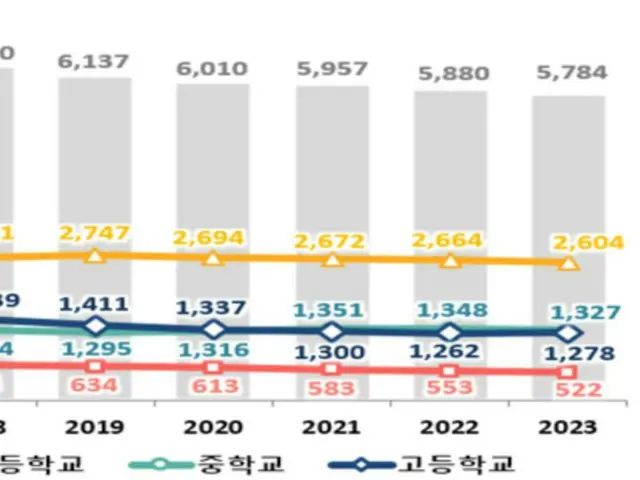exceeded 180,000, setting a record high. The South Korean Ministry of Education and the Korea Educational Development Institute announced the results of the 2023 Education Basic Statistics Survey on the 30th. This survey covers 20,906 kindergartens, elementary, junior high, and high schools.
1,937 institutions of higher education. According to this announcement, as of April 1 this year, the number of students in kindergarten, elementary school, junior high school and high school was 5,783,612, a year-on-year increase of 96,156.
(1.6%) decrease. After hitting a high of 10.31 million students in 1986, the number of students began to decline, falling below 10 million in 1990, and falling below 6 million last year.
The number of kindergarten children decreased by 5.6% to 511,794, the highest rate of decrease. Elementary school students decreased by 2.3% to 2,603,929 students, and junior high school students decreased by 1.6% to 1,326,831 students.
It was. On the other hand, the number of high school students increased by 1.3% to 1,278,269, as more people born in 2007, the year known as the "Year of the Golden Pig," entered high school.
The number of kindergartens, elementary schools, junior high schools, and high schools nationwide was 20,605, a decrease of 91 schools. The number of kindergartens decreased by 121, while the number of elementary and junior high schools decreased by 121.
・All high schools saw a slight increase. The number of elementary, middle, and high school students from multicultural families (international marriages and immigrant families) increased by 7.4% to 181,178. The number of children in multicultural households has been on the rise since 2012.
The number of students enrolled at higher education institutions such as universities, junior colleges, and graduate schools (current students and students on leave of absence) is also decreasing. The total number of students enrolled in higher education institutions decreased by 2.5% to 3,042,848. general university (1
The number of students enrolled in graduate schools (down .8%) and junior colleges (down 5.6%) decreased, and only the number of students enrolled in graduate schools increased by 0.8%. On the other hand, the number of foreign students (enrollment standards) was 181,842, 14,950 (9%
) increased to a record high. The number of foreign students enrolled in degree programs was 129,240, an increase of 4,437 (3.6%). Accounting for 4.2% of the total number of students enrolled in higher education institutions (3,042,848 people)
I got it. The number of foreign students enrolled in non-degree programs was 52,602 (28.9%), an increase of 10,513 (25%).
The number of foreign students has been increasing since 2014, but from 2020 to 2021 the number of foreign students will increase due to the new coronavirus.
It was stagnant due to the influence of the coronavirus infection. The country has been on a recovery trend since last year when COVID-19 prevention measures were eased.
By country, China accounted for 37.4% (68,065 people) and Vietnam accounted for 23.8% (43,361 people).
), Uzbekistan and Mongolia (5.7% each), and Japan 3.2%.
2023/08/31 06:24 KST
Copyrights(C) Herald wowkorea.jp 104

